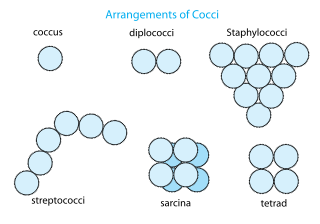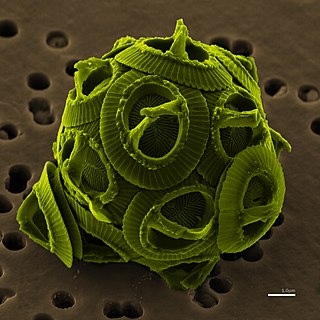The present disambiguation page holds the title of a primary topic , and an article needs to be written about it. It is believed to qualify as a broad-concept article . It may be written directly at this page or drafted elsewhere and then moved over here. Related titles should be described in Coccoid, while unrelated titles should be moved to Coccoid (disambiguation). |
| Look up coccoid in Wiktionary, the free dictionary. |
Coccoid means shaped like or resembling a coccus, that is, spherical.
The noun coccoid or coccoids may refer to:
- a level of organization, characterized by unicellular, non-flagellated, non-amoeboid organisms, with a definite shape, in general but not always ovoid. It is found in many groups, e.g.:
- some bacteria, also called cocci (pl. of coccus)
- some green algae, like the desmids and the former Chlorococcales (now in several orders within the division Chlorophyta)
- some dinoflagellates, notably Symbiodinium
- some chrysophytes
- some xanthophytes
- the diatoms

Chlorococcales is an order of green algae in the class Chlorophyceae. Individual specimens are sometimes found in soil, but mostly in fresh and marine waters. The order contains approximately 780 species.

The dinoflagellates are a classification subgroup of algae. They are a large group of flagellate eukaryotes that constitute the phylum Dinoflagellata. Most are marine plankton, but they also are common in freshwater habitats. Their populations are distributed depending on sea surface temperature, salinity, or depth. Many dinoflagellates are known to be photosynthetic, but a large fraction of these are in fact mixotrophic, combining photosynthesis with ingestion of prey (phagotrophy). In terms of number of species, dinoflagellates are one of the largest groups of marine eukaryotes, although this group is substantially smaller than diatoms. Some species are endosymbionts of marine animals and play an important part in the biology of coral reefs. Other dinoflagellates are unpigmented predators on other protozoa, and a few forms are parasitic. Some dinoflagellates produce resting stages, called dinoflagellate cysts or dinocysts, as part of their lifecycles.

Symbiodinium is a genus that encompasses the largest and most prevalent group of endosymbiotic dinoflagellates known. These unicellular algae commonly reside in the endoderm of tropical cnidarians such as corals, sea anemones, and jellyfish, where the products of their photosynthetic processing are exchanged in the host for inorganic molecules. They are also harbored by various species of sponge, flatworms, mollusks such as the giant clams, foraminifera (soritids), and some ciliates. Generally, these dinoflagellates enter the host cell through phagocytosis, persist as intracellular symbionts, reproduce, and disperse to the environment. The exception is in most mollusks, where Symbiodinium are intercellular. Cnidarians that are associated with Symbiodinium occur mostly in warm oligotrophic (nutrient-poor), marine environments where they are often the dominant constituents of benthic communities. These dinoflagellates are therefore among the most abundant eukaryotic microbes found in coral reef ecosystems.
- the superfamily Coccoidea of scale insects
- the Coccidae family within the Coccoidea

Bacteria are a type of biological cell. They constitute a large domain of prokaryotic microorganisms. Typically a few micrometres in length, bacteria have a number of shapes, ranging from spheres to rods and spirals. Bacteria were among the first life forms to appear on Earth, and are present in most of its habitats. Bacteria inhabit soil, water, acidic hot springs, radioactive waste, and the deep portions of Earth's crust. Bacteria also live in symbiotic and parasitic relationships with plants and animals. Most bacteria have not been characterised, and only about half of the bacterial phyla have species that can be grown in the laboratory. The study of bacteria is known as bacteriology, a branch of microbiology.

A coccus is any bacterium or archaeon that has a spherical, ovoid, or generally round shape. It is one of the three distinct bacterial shapes, the other two being bacillus (rod-shaped) and spiral-shaped cells.

The green algae are a large, informal grouping of algae consisting of the Chlorophyta and Charophyta/Streptophyta, which are now placed in separate divisions, as well as the potentially more basal Mesostigmatophyceae, Chlorokybophyceae and Spirotaenia.










